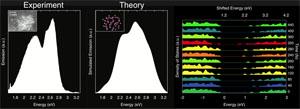
Left: Experimental and theoretically predicted white light spectrum from CdSe nanoclusters (shown inset). Right, calculated density of states as a function of time, color-coded according to the color of the band gap. The fluctuating band gap leads to white light emission.
Combined scanning transmission electron microscopy (STEM) observations and density functional theory (DFT) calculations show why nanoparticles, which typically emit monochromatic light at an energy tuned by their size, suddenly are able to individually emit white light. White-light emission from nanoparticles is of importance due to its potential for energy efficient solid state lighting. The transition from monochromatic to white light emission occurs at a diameter of around 2 nm. This size marks the point at which the majority of atoms in a nanoparticle are at its surface, and this study shows that such a predominance of surface atoms destabilizes nanocrystals, causing them to take on a dynamic disordered structure when excited. This fluxionality leads to rapidly varying electronic structure. In fact, in ultrasmall (sub-2-nm) CdSe, the fluctuations cause their band gaps to vary continuously across the visual range on a femtosecond time scale. Transitions across all these different band gaps result in the white light emission. In addition, fluxionality also exists at the surfaces of all the larger nanocrystals observed. This description of a nanocrystal surface is quite different from the concept of a stable trap state and may be critical for utilizing such nanoclusters for solid state lighting.
For more information please contact Steve Pennycook, pennycooksj@ornl.gov
T. J. Pennycook, J. R. McBride, S. J. Rosenthal, S. J. Pennycook, and S. T. Pantelides, "Dynamics fluctuations in ultrasmall nanocrystals induce white light emission," Nano Letters, 12, 3038 (2012).

